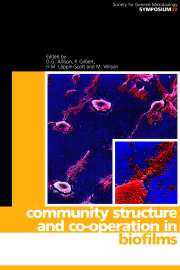Book contents
- Frontmatter
- Contents
- Contributors
- Editors' Preface
- An overview of biofilms as functional communities
- Initial microbial adhesion events: mechanisms and implications
- Physiological events in biofilm formation
- Environmental and genetic factors influencing biofilm structure
- Coaggregation and coadhesion in oral biofilms
- Cohesiveness in biofilm matrix polymers
- Microbial detachment from biofilms
- Modelling and predicting biofilm structure
- Microbial community interactions in biofilms
- Microbial communities: aggregates of individuals or co-ordinated systems
- Gene transfer in biofilms
- Population dynamics in microbial biofilms
- Biodegradation by biofilm communities
- Biofilms and prosthetic devices
- Biofilms: problems of control
- Biofilms in the New Millennium: musings from a peak in Xanadu
- Index
Biofilms and prosthetic devices
Published online by Cambridge University Press: 03 June 2010
- Frontmatter
- Contents
- Contributors
- Editors' Preface
- An overview of biofilms as functional communities
- Initial microbial adhesion events: mechanisms and implications
- Physiological events in biofilm formation
- Environmental and genetic factors influencing biofilm structure
- Coaggregation and coadhesion in oral biofilms
- Cohesiveness in biofilm matrix polymers
- Microbial detachment from biofilms
- Modelling and predicting biofilm structure
- Microbial community interactions in biofilms
- Microbial communities: aggregates of individuals or co-ordinated systems
- Gene transfer in biofilms
- Population dynamics in microbial biofilms
- Biodegradation by biofilm communities
- Biofilms and prosthetic devices
- Biofilms: problems of control
- Biofilms in the New Millennium: musings from a peak in Xanadu
- Index
Summary
THE USE OF PROSTHETIC DEVICES IN MEDICINE
Prosthetic devices are used to repair or replace a structure or function which has been damaged or is absent as a result of disease, trauma (including surgery) or congenital defect. The limits on their use are considerations of mechanical properties or function, and biocompatibility, and these are progressively being overcome as new biomaterials are developed. However, most prosthetic devices in common use are made from a narrow range of biomaterials, such as silicone elastomer, polyurethanes, fabricated polytetrafluoroethylene (Teflon) or polyethylene terephthalates (Dacron), titanium, stainless steel, ceramics and composite materials containing carbon or glass fibres.
Most prosthetic devices are used in either children or the elderly, and the proportion of the population comprising these two age groups is increasing in most developed countries. It is likely, therefore, that the absolute numbers of prosthetic devices used each year will rise rapidly. Examples of such devices are large joint (hip, knee, shoulder, etc.) replacements for arthritis, spinal fixation to stabilize the spine after cancer or trauma, prosthetic heart valves, pacemakers, vascular grafts for obstructed or weakened major arteries, voice prostheses for those whose larynx has been removed because of cancer or trauma, central venous catheters for parenteral nutrition or anticancer drug administration, catheters for peritoneal dialysis for those with renal failure, and shunts to control hydrocephalus, or pathological accumulation of fluid in the brain.
Incidence and resource implications of device-related infection
While biodeterioration or mechanical dysfunction are important complications, the most feared is infection, which occurs at widely varying rates between devices.
- Type
- Chapter
- Information
- Community Structure and Co-operation in Biofilms , pp. 295 - 308Publisher: Cambridge University PressPrint publication year: 2000
- 6
- Cited by



